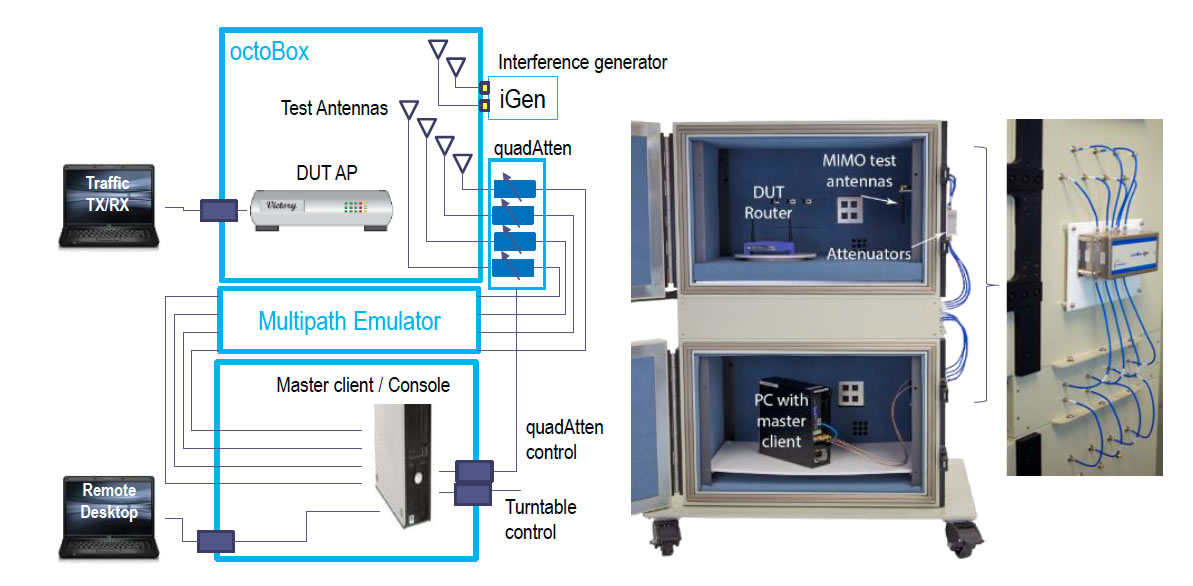- 2016
- -
- 01
- -
- 02
-
Solving the Wireless Test Repeatability Puzzle
by Patrick Mannion in Test.Pass of Electronic Design Magazine
你如何对各种无线产品,包括Wi-Fi、蓝牙、ZigBee、LTE-U、微波炉和婴儿监视器...等无线产品, 在大量宽带和窄带干扰的状况下进行一致和可靠的测试?这里有一个合适的测试设备:
octoScope公司的octoBox测试设备,包括两个隔离室,IGEN干扰发生器,和quadAtten可控制衰减器,可对各种无线产品进行快速和可重复的测试。
无线产品没有同轴电缆连接口可以用来提供可控制的干扰,而排除非测试相关的干扰需要昂贵的大型设备,另外测试时间也希望能在几分钟完成,而不是几小时或几天。测试也需要从2×2到8×8及以上 MIMO的可扩展性。这也需要高达至少16 tx/rx 天线来进行测试。这些是我上周拜访octoScope时,发现可以解决的问题。
請參閱: http://bit.ly/1Oq9FZg (Electronic Design Magazine)
These are the issues that I found octoScope solving when I dropped by last week. Having tracked the company since Fanny Mlinarsky founded it in 2006 as a consultancy, it was exciting to see how it had evolved to offer a full two-chamber octoBox Testbed to tackle and solve the puzzle presented above.
Its testbed could not have come at a better time. With the Internet of Things (IoT) about to flood our farms, factories, hospitals, cities, and homes with RF, and telecom carriers also pushing their way into the unlicensed bands with LTE-Unlicensed and License Assisted Access, the airwaves are about to get very crowded indeed.
Fanny wasn't there when I stopped by, but Randy Oltman (formerly of Spirent and Teradyne), who recently joined as VP of marketing, gave Electronic Design an overview of the new Platform. You can watch the video below.
He also elaborated on the challenges he sees facing wireless system designers, which basically can be summed up in two words: coexistence and adaptation. Hundreds of devices competing for space in a typical home makes for an interesting simulation problem. That’s where the octoBox testbed comes in.
The latest version of octoBox comprises two anechoic chambers that are completely isolated using layers of impedance-matched carbon-impregnated RF-absorbing foam, and tuned to the range of 600 MHz to 6 GHz. The top chamber houses the access point, while the client or “device under test” (DUT) is placed in the second chamber beneath.
It's this almost complete isolation that allows for repeatable behavioral analysis under interference, as well as throughput performance checking, roaming behavior, interoperability, and the ability to emulate a multi-room house.
The test waveforms are supplied by the external quadAtten, which comprises four different electrically controlled attenuators that allow the tester to effectively adjust the range of the two devices to emulate motion and variable range.
Stacked on quadAtten is the iGen interference generator, which simulates narrowband interference, from baby monitors, microwave ovens, and traffic radar, for example, as well as wideband signals from ZigBee, Wi-Fi, and LTE networks.
“We can simulate Wi-Fi traffic and fully observe Wi-Fi protocols, but insert a great amount of traffic to load down the channels and see how the devices perform under channel loading, all simultaneously,” says Oltman. The iGen interference patterns can be controlled using a Web interface or API and is dynamically changing based on how it’s programmed.
The ultimate challenge octoScope is working on is to ensure hundreds of devices can coexist in an environment such as the home. Along with classic home networks, carriers are now fighting to insert LTE and LAA into unlicensed bands, bonding 20-MHz data carriers to their existing spectrum in the licensed bands.
“The big question is how they behave in the presence of Wi-Fi, and vice versa,” says Oltman. It’s early days yet, and the results are mixed. While the respective groups are working closely together, according to Oltman, “there is a wide number of devices on either side, and many of the sensing and adaptation algorithms are proprietary, so a lot of testing has to happen. So that’s something engineers need to be concerned about.”
Historically, the required tests would have been done in shielded enclosures, or even over open air, but shielded enclosures are subject to reflections, internally, while open-air tests are subject to ambient interference, which eliminates consistency. “They need to be able to create tests and have them be repeatable, which is where we come in,” says Oltman.
Of course, massive EMC houses could be built for millions of dollars of capital expenditure, but the octoBox “is portable and easily wheeled to where it needs to be,” he says, adding that “out of the box, it’s up and running in an hour.” Depending on the density of points you want to check and the types of tests you’d like to perform, it can take anywhere from 15 minutes to a few hours to get results.
It's important to point out that this isn't full-on EMC testing, but is instead a means of testing to get a rough estimate of the antenna pattern, or check for blind spots in your access point in terms of its antenna shape.
“Also,” Oltman adds, “with so many field firmware updates for devices, there is a tremendous need for software regression testing and behavioral testing, especially as we start to look at fast roaming and handoff between access points, as well as the movement of devices, the variable loading of channels, or the need for an AP to dynamically adapt for different channels.”
Tests also could be done using cables to carry the interference signal, but with wireless data combining with wireless power or energy harvesting, it won’t be long until devices have zero ports, for data or power. These “things,” whether they be wireless sensing nodes or mobile devices in the middle of our homes, will number in the hundreds, if not thousands, and will form the basis of the IoT we are tumbling toward, but first they have to work together.
OctoScope seems to have a good solution to help you solve a major obstacle in the way of that “togetherness.”
News最新消息


 | 上海市中山西路999号华闻国际大厦609室
| 上海市中山西路999号华闻国际大厦609室